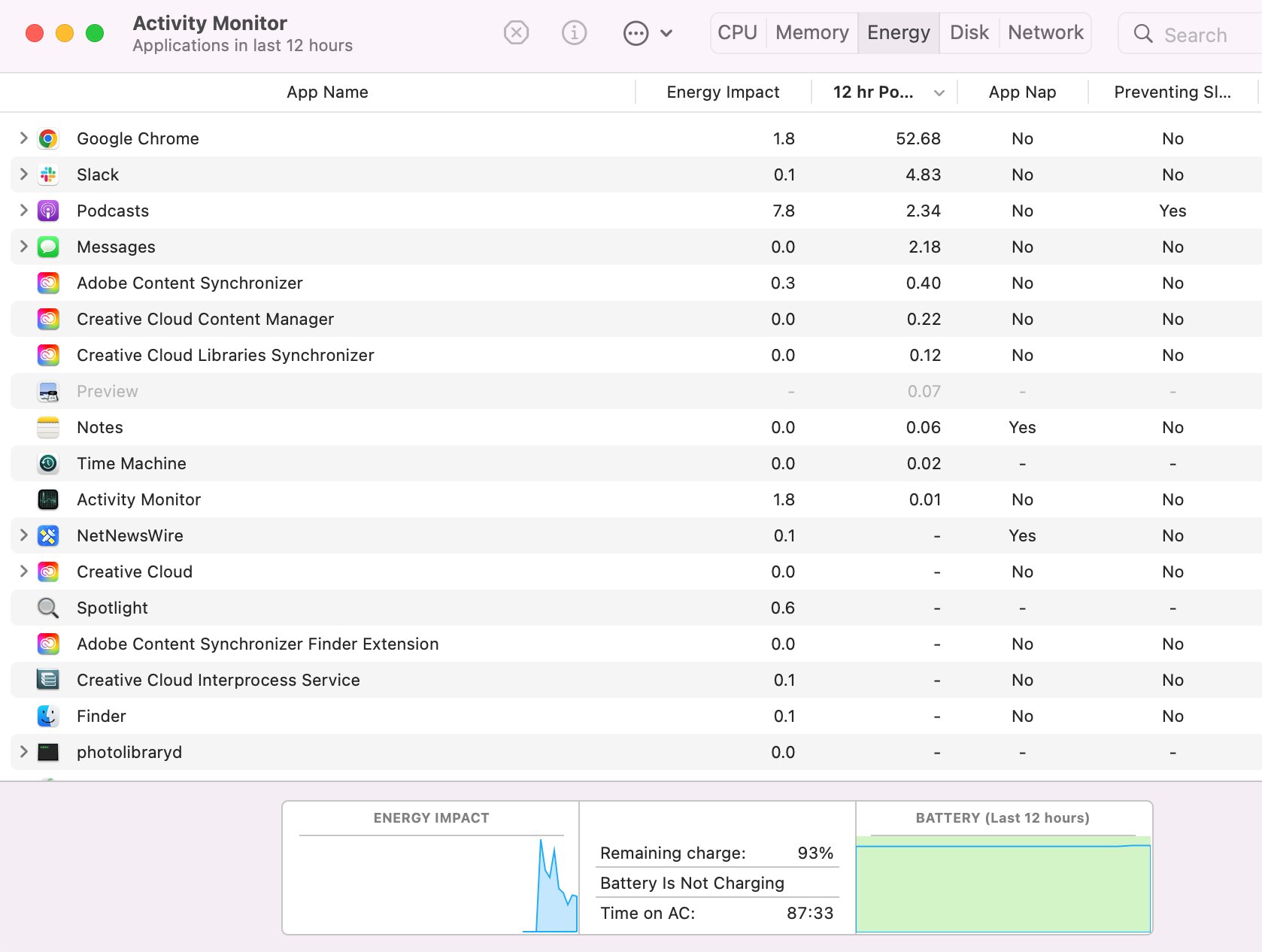If you recently moved your Mac to the latest version of macOS Sonoma, and your Mac’s battery seems to be draining faster than it should be, there are some steps you should take before contacting with Apple customer service.
Restart Your Mac
If you start to notice abnormal battery drain on your Mac, the first step is a simple restart.
Power your Mac down, wait for a minute, and power it back on and see if battery life improves. If it doesn’t, move onto the next steps.
Update Your Mac
Apple will occasionally release new macOS Sonoma software. Point updates (x.x.x) typically patch up bugs and security issues while milestone upgrades (x.x) usually deliver a mix of features and fixes.

Apple may not list fixes for battery drain issues in a macOS Sonoma update’s change log. However, new software always has the potential to help. If your Mac is running outdated software, updating could help.
For more on the latest version of macOS Sonoma, check out our guide.
Update Your Apps
Developers push a constant stream of updates to the App Store and a new version could help alleviate macOS Sonoma battery life drain.
Go into the Mac App Store and check for recent updates. If you’re feeling leery, dig into reviews from Mac users currently running macOS Sonoma.
You’ll also want to click on the battery icon in the upper right corner of your Mac.
If you see an app “Using Significant Energy” you’ll want to check in with the developer to see if there’s update, an update planned, or if there’s a known issue with macOS Sonoma.
Check Processes
It could be that one, or more, of your applications are hogging your Mac’s resources. This will cause the battery to drain rapidly. You can investigate using the built-in Activity Monitor feature.

In the Finder, find Activity Monitor and open it. You should be on a screen like the one in the screenshot above. Now, click the Energy tab.
Now click the Energy Impact tab. This will sort the list by the apps and processes using up the most energy. If you see an app or process utilizing a ton of energy, highlight it and click the “X” in the toolbar.
Check Your Battery Usage History
Usage History gives you details about your Mac’s battery life over the last 24 hours or the last 10 days. You’ll find it in your Mac’s System Settings, located in the “Battery” section.
It’s broken down into Battery Level and Screen On Usage so you can see how your Mac’s battery is currently performing. If the readouts don’t look right, you might need to get into contact with Apple customer service.
You’ll also notice Battery and Power Adapter sections. You can select when to turn your Mac’s display off, turn power nap on or off, and a whole lot more.
Turn Down Screen Brightness
If you constantly have your Mac’s display set at maximum brightness, that could be the issue.
We recommend enabling the “Automatically adjust brightness” feature on your device to help prevent battery drain. This option is only available if you own a Mac with an ambient light sensor.
Here’s how you enable it:
- Click the Apple logo in the top left corner of the screen
- Select System Settings
- Click Displays in the sidebar
- Toggle Automatically adjust brightness on
You can also manually adjust the brightness of your Mac’s display. One way is to use the F1 and F2 keys on the keyboard.
The other way is to use Control Center, located in the upper right-hand corner, and adjust the brightness using the slider located there.
Disable Login Items
Some apps might launch automatically upon startup and run in the background.
If you don’t need them to, go into your Mac’s settings and find Login Items (you can use the search function to do so) and see if there are apps listed there that you don’t need on startup. Remove as needed.
Reset PRAM and NVRAM
If nothing above works, you can try resetting your MacBook’s PRAM and NVRAM. This resets some settings, but it doesn’t delete your Mac’s data.
Here’s how to do this. Note that this will only work with Intel-based MacBook models:
- Use the power button to turn your MacBook off
- Press the power button to turn your MacBook back on
- While it’s starting, press and hold the Command + Option + P + R keys together
- Continue holding the keys until you hear the startup sound twice
- Release the keys and allow your MacBook to start up normally
Reset SMC
The System Management Controller (SMC) manages hardware functions like your MacBook’s battery. You can try resetting it to see if it helps improve battery life:
- Use the power button to turn your MacBook off
- Press and hold the Shift + Control + Option keys and the power button simultaneously for 10 seconds
- Release all keys and the power button
- Press the power button to turn your MacBook back on
If you have a MacBook Pro or MacBook Air with Apple silicon, you simply need to restart your device.
Downgrade
If you can’t find a fix for your problem and/or don’t want to wait for the next version of macOS Sonoma, you can try downgrading your Mac’s software back to an older version.
For more about the macOS downgrade, take a look at our walkthrough.
4 Reasons Not to Install macOS Sonoma 14.4 & 10 Reasons You Should
Install macOS Sonoma 14.4 for Better Security |
|
 |
|
|
If security is important to you, think about installing Apple’s macOS Sonoma 14.4 update right away. macOS Sonoma 14.4 brings 50+ security updates to compatible Mac devices making it an extremely important download. The update also delivers quantum security protection for iMessage. Apple says the upgrade gives iMessage “the strongest security properties of any at-scale messaging protocol in the world.” You’ll also get patches from updates you missed when you upgrade to macOS Sonoma 14.4. Apple’s macOS Sonoma 14.3 update brought 16 new security patches to Mac. These will help keep your device and its data protected from harm. macOS Sonoma 14.2.1 featured one security patch and it fixed an issue where a user who shares their screen may unintentionally share the incorrect content. macOS Sonoma 14.2 included a whopping 20 security patches for your Mac. If you want to learn more about them, head here. The software also included iMessage Contact Key Verification which improves the security of iMessage. macOS Sonoma 14.1.2 delivered two security patches, both related to WebKit. These patches were extremely important. macOS Sonoma 14.1 had numerous security patches on board and they addressed issues with Photos, Safari, Siri and more. You can learn more about them over at Apple. macOS Sonoma 14.0, the first version of macOS Sonoma, brought a ton of new security patches to Mac. And when we say a ton, we mean a ton. It delivered over 50 security updates to Mac users. You can learn more about the particulars over on Apple’s security site. In addition to the patches, macOS Sonoma brings additional enhancements to privacy and security including improvements to Communication Safety beyond Messages. It now includes content sent and received in the systemwide photo picker and third-party apps. You also have an option to blur out sensitive photos and videos before you choose to view them. There’s also an expanded Lockdown Mode which will help protect you against cyber attacks and improved sharing permissions which means you have more control over what you share with the apps on your device. If you skipped older versions of macOS, you’ll get the security patches from those updates with your macOS Sonoma 14.4 update. |
|











